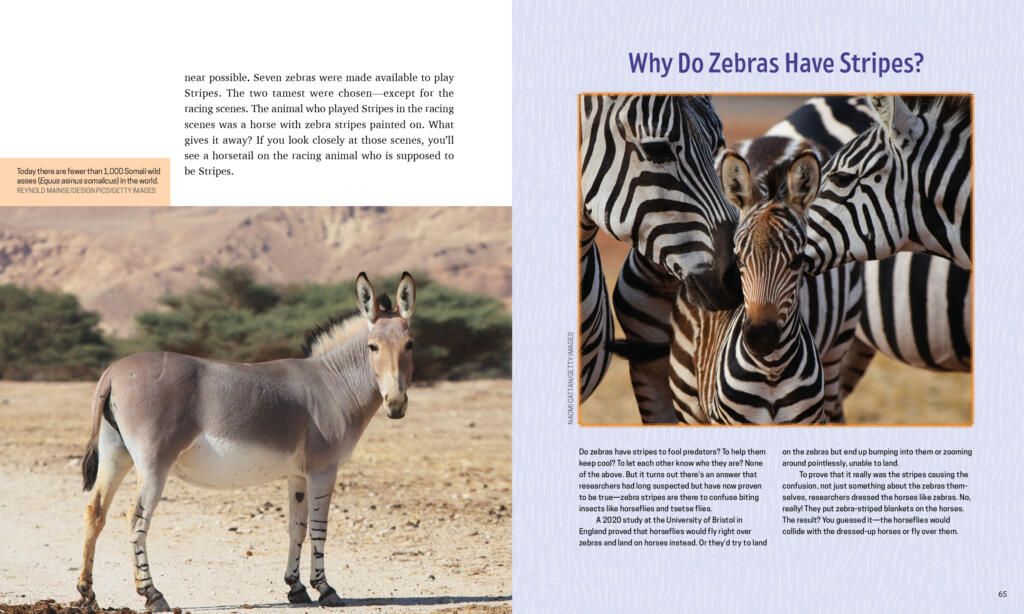Relationship between humans and horses
Wild Horses Running Free
by Linda L. Richards
Victoria: Orca Book Publishers, 2023
$24.95 / 9781459825598
Reviewed by Valerie Green
*

“Everybody loves horses. The flowing mane and tail. Those big, lovely eyes and long elegant legs. Horses make us think of strength and speed and the sense of flight we can enjoy when we ride.”
This is how Linda L. Richards introduces her readers to the story of the horse, the genus Equus. Not only does she tell us the history of the horse, but more particularly she describes the wild horses that roam the plains of North America and how their existence is under threat as the environment around them is changing. This threat has become a strong issue between governments and activists.

In her Introduction, the author states: “When I was growing up, my bedroom was full of horses – stuffed, soft, smooth and plastic” and they all had names. Her obsession with horses spread to her book collection which included The Black Stallion and Black Beauty. She was simply horse crazy. When she was 12, her family purchased 20 acres and she knew a real horse would be in her future.
When a horse she named Bonnie showed up one day on their acreage, the author was convinced the horse was a wild horse which was not realistic in Langley, British Columbia. Nonetheless, the author decided to try and “tame” Bonnie who appeared to be slowly taking to her and even allowed her to sit on her back without bucking. She convinced herself she had tamed a wild mustang!
Unfortunately, Bonnie was not a wild horse but in fact belonged to a nearby farmer and had escaped her pen. The author was heartbroken when a trailer came to pick up the horse. “But I never forgot my ‘mustang’ Bonnie who, though not an actual mustang, embodied the spirit, connection, and idea of one.”
From then on, Richards identified most strongly with the American mustang found in the western United States while at the same time researching their stories all around the world. As she pursued that topic for this book, she began to realize that there are many people who do not want horses to be free because they interfere with the use of the land—for government purposes like extraction and mining. In addition, farmers who graze the land with their cattle or sheep believe that the wild horse competes with their own livestock for food.
Having discovered all these facts, Richards decided to turn her original book idea of simply reporting on the evolution, beauty, and inspiration of the wild horses, into something much more important; to make sure their preservation in the wild is not only necessary and indeed possible but also because it can benefit everyone. The result is a beautifully written and illustrated story of their history, biology, and ecology, and the story will be savoured by horse lovers everywhere.

In Part One, Richards introduces her readers to what in fact a wild horse is. In Part Two she talks of their natural home and what they eat. In Part Three, she goes on to specifically talk about the American mustang. Part Four brings in discussions about wild horses around the world in India, Australia, Portugal, and the United Kingdom, as well as describing Konik horses, asses, burros, and zebras and their place in the genus Equus.
In the final section of her book, Richards introduces subjects concerning the environment, equine firefighters, and the people who are protecting wild horses while looking into their future. The author also discusses the important relationships between Indigenous people and the horse.
Many people and organizations are fighting for the future of the mustang including the American Wild Horse Campaign, Return to Freedom, the Cloud Foundation, and Blue Equus to name a few. While they all agree that what the BLM (Bureau of Land Management) is doing is wrong, they are not all in agreement about how the problem should be solved to protect the wild horses.

Some believe the solution lies in a round-up to sell horses and let them live their lives out comfortably away from the wild. Others believe that nature should be allowed to take its course—horses eaten by predators or dying of starvation or dehydration. Other groups believe in the administration of contraception to control the number of foals born every year.
There is obviously no perfect answer for protection of the wild horse, but attempts are being made so the future looks good.
At the end of her book, Richards uses two quotes that explain how the horse is a symbol of freedom and hope. The first is by Winston Churchill that he said during the Second World War: “there is something about the outside of a horse that is good for the inside of a man. Horses reflect humanity.” The second is by Australian poet Pam Brown who wrote: “A horse is the projection of people’s dreams about themselves—strong, powerful, beautiful—and it has the capability of giving us escape from our mundane existence.”
The author ends her book by saying that “wild horses are all of that and more . . . preserving them in the wild gives us hope.”
The entire book is complimented by many delightful additional stories in sidebars, as well as a thorough glossary and a list of all of Richards’ resources, in addition to a selection of incredible photographic illustrations that are second to none.
Linda Richards is from Vancouver, British Columbia and her book will be treasured by all who love and respect horses.

*

Valerie Green was born and educated in England where she studied journalism and law. Her passion was always writing from the moment she first held a pen in her hand. After working at the world-famous Foyles Books on Charing Cross Road, London, followed by a brief stint with M15 and legal firms, she moved to Canada in 1968 where she married and raised a family, while embarking on a long career as a freelance writer, columnist, and author of over twenty non-fiction historical and true-crime books. Hancock House recently released the first three books—Providence, Destiny, and Legacy—of Valerie’s four-book historical fiction series The McBride Chronicles, a historical family saga that brings early BC history alive. Now semi-retired (although writers never really retire!) she enjoys taking short road trips around BC with her husband, watching their two beloved grandsons grow up and, of course, writing. [Editor’s note: Valerie Green has recently reviewed books by Patti Shales Lefkos, Reed Stirling, Padma Viswanathan, Carolyn Redl, Jennifer Manuel, and Beka Shane Denter for the BC Review.]
*
The British Columbia Review
Interim Editors, 2023-24: Trevor Marc Hughes (non-fiction), Brett Josef Grubisic (fiction)
Publisher: Richard Mackie
Formerly The Ormsby Review, The British Columbia Review is an on-line book review and journal service for BC writers and readers. The Advisory Board now consists of Jean Barman, Wade Davis, Robin Fisher, Barry Gough, Hugh Johnston, Kathy Mezei, Patricia Roy, Maria Tippett, and Graeme Wynn. Provincial Government Patron (since September 2018): Creative BC. Honorary Patron: Yosef Wosk. Scholarly Patron: SFU Graduate Liberal Studies. The British Columbia Review was founded in 2016 by Richard Mackie and Alan Twigg.
“Only connect.” – E.M. Forster
8 comments on “Relationship between humans and horses”